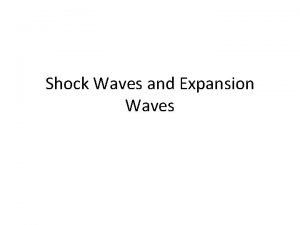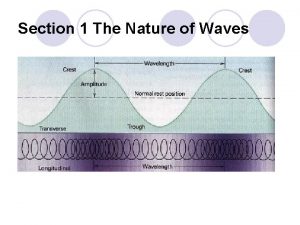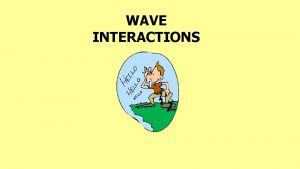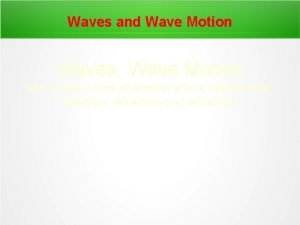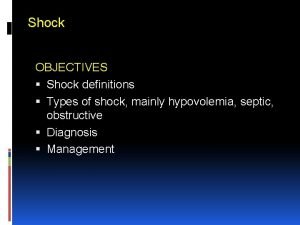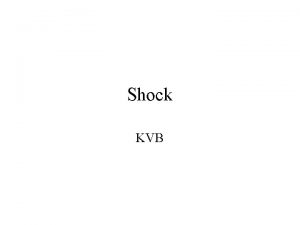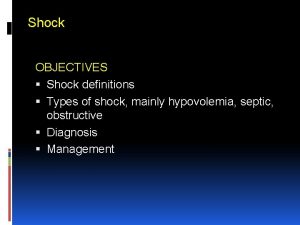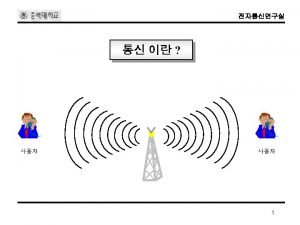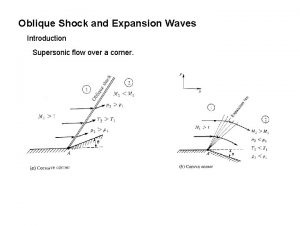Shock Waves and Expansion Waves 1 Shock Wave



![• 1] Shock Wave • * The extremely thin region in which the • 1] Shock Wave • * The extremely thin region in which the](https://slidetodoc.com/presentation_image_h/f699343f44e02fc6ccf0cc82d311e7e6/image-4.jpg)































- Slides: 35

Shock Waves and Expansion Waves


![1 Shock Wave The extremely thin region in which the • 1] Shock Wave • * The extremely thin region in which the](https://slidetodoc.com/presentation_image_h/f699343f44e02fc6ccf0cc82d311e7e6/image-4.jpg)
• 1] Shock Wave • * The extremely thin region in which the transition from the supersonic velocity, relatively low pressure state to the state that involves a relatively low velocity and high pressure is termed a shock wave. • * finite pressure disturbance, compressive elastic wave of finite strength • * nonlinear addition of the individual Mach waves emitted from each point on the body of finite thickness (or finite attack angle, not point projectile). • * The shock wave is an abrupt disturbance that causes discontinuous and irreversible changes in such fluid properties as


A spectacular hydraulic jump at the end of a spillway.



Shock Waves and Expansion Waves • Review – Sound waves are created by small pressure disturbances and travel at the speed of sound – For some back pressures, abrupt changes in fluid properties occur in C-D nozzles, creating a shock wave • Here, we will study the conditions under which shock waves develop and how they affect the flow.

Shock Waves and Expansion Waves Normal Shocks • Shocks which occur in a plane normal to the direction of flow are called normal shock waves • Flow process through the shock wave is highly irreversible and cannot be approximated as being isentropic • Develop relationships for flow properties before and after the shock using conservation of mass, momentum, and energy

Shock Waves and Expansion Waves Normal Shocks Conservation of mass Conservation of energy Conservation of momentum Increase in entropy










Define strength of a shock wave. Strength of a shock wave is defined as the ratio of increase in static pressure across the shock to the inlet static pressure.

Shock Waves and Expansion Waves Normal Shocks • Combine conservation of mass and energy into a single equation and plot on h-s diagram – Fanno Line : locus of states that have the same value of h 0 and mass flux • Combine conservation of mass and momentum into a single equation and plot on h-s diagram – Rayleigh line • Points of maximum entropy correspond to Ma = 1. – Above / below this point is subsonic / supersonic

Shock Waves and Expansion Waves Normal Shocks • There are 2 points where the Fanno and Rayleigh lines intersect : points where all 3 conservation equations are satisfied – Point 1: before the shock (supersonic) – Point 2: after the shock (subsonic) • The larger Ma is before the shock, the stronger the shock will be. • Entropy increases from point 1 to point 2 : expected since flow through the shock is adiabatic but irreversible

Shock Waves and Expansion Waves Normal Shocks • Equation for the Fanno line for an ideal gas with constant specific heats can be derived • Similar relation for Rayleigh line is • Combining this gives the intersection points

Shock Waves and Expansion Waves Oblique Shocks • Not all shocks are normal to flow direction. • Some are inclined to the flow direction, and are called oblique shocks

Shock Waves and Expansion Waves Oblique Shocks • At leading edge, flow is deflected through an angle called the turning angle • Result is a straight oblique shock wave aligned at shock angle relative to the flow direction • Due to the displacement thickness, is slightly greater than the wedge half -angle .

Shock Waves and Expansion Waves Oblique Shocks • Like normal shocks, Ma decreases across the oblique shock, and are only possible if upstream flow is supersonic • However, unlike normal shocks in which the downstream Ma is always subsonic, Ma 2 of an oblique shock can be subsonic, or supersonic depending upon Ma 1 and .

Shock Waves and Expansion Waves Oblique Shocks • All equations and shock tables for normal shocks apply to oblique shocks as well, provided that we use only the normal components of the Mach number -Ma relationship – Ma 1, n = V 1, n/c 1 – Ma 2, n = V 2, n/c 2

Shock Waves and Expansion Waves Oblique Shocks

Shock Waves and Expansion Waves Oblique Shocks • If wedge half angle > max, a detached oblique shock or bow wave is formed • Much more complicated that straight oblique shocks. • Requires CFD for analysis.

Shock Waves and Expansion Waves Oblique Shocks • Similar shock waves see for axisymmetric bodies, however, -Ma relationship and resulting diagram is different than for 2 D bodies

Shock Waves and Expansion Waves Oblique Shocks • For blunt bodies, without a sharply pointed nose, = 90 , and an attached oblique shock cannot exist regardless of Ma.

Shock Waves and Expansion Waves Prandtl-Meyer Expansion Waves • In some cases, flow is turned in the opposite direction across the shock • Example : wedge at angle of attack greater than wedge half angle • This type of flow is called an expanding flow, in contrast to the oblique shock which creates a compressing flow. • Instead of a shock, a expansion fan appears, which is comprised of infinite number of Mach waves called Prandtl-Meyer expansion waves • Each individual expansion wave is isentropic : flow across entire expansion fan is isentropic • Ma 2 > Ma 1 • P, , T decrease across the fan Flow turns gradually as each successful Mach wave turns the flow ay an infinitesimal amount

Shock Waves and Expansion Waves Prandtl-Meyer Expansion Waves • Prandtl-Meyer expansion fans also occur in axisymmetric flows, as in the corners and trailing edges of the cone cylinder.

Shock Waves and Expansion Waves Prandtl-Meyer Expansion Waves Interaction between shock waves and expansions waves in “over expanded” supersonic jet
 Spinal shock vs neurogenic shock
Spinal shock vs neurogenic shock Normovolemico
Normovolemico Spinal shock vs neurogenic shock
Spinal shock vs neurogenic shock Spinal shock symptoms
Spinal shock symptoms Spinal shock vs neurogenic shock
Spinal shock vs neurogenic shock Oblique shock angle
Oblique shock angle Compare and contrast p waves and s waves using venn diagram
Compare and contrast p waves and s waves using venn diagram Wave shock marine biology
Wave shock marine biology Difference between full wave and half wave rectifier
Difference between full wave and half wave rectifier Transverse and longitudinal waves both *
Transverse and longitudinal waves both * Full wave rectifier circuit
Full wave rectifier circuit Earthquake p wave and swave travel time
Earthquake p wave and swave travel time Venn diagram of mechanical and electromagnetic waves
Venn diagram of mechanical and electromagnetic waves Mechanical and electromagnetic waves similarities
Mechanical and electromagnetic waves similarities Wavelength formula triangle
Wavelength formula triangle Ability of two or more waves to combine and form a new wave
Ability of two or more waves to combine and form a new wave Parts of a longitudinal wave
Parts of a longitudinal wave Mechanical and electromagnetic waves similarities
Mechanical and electromagnetic waves similarities Short wave vs long wave radiation
Short wave vs long wave radiation Mechanical waves and electromagnetic waves similarities
Mechanical waves and electromagnetic waves similarities Similarities of mechanical and electromagnetic waves
Similarities of mechanical and electromagnetic waves Seismic waves
Seismic waves Differences between constructive and destructive waves
Differences between constructive and destructive waves Light is electromagnetic radiation true or false
Light is electromagnetic radiation true or false Full wave rectifier vs half wave rectifier
Full wave rectifier vs half wave rectifier Rectified sine wave fourier series
Rectified sine wave fourier series What is a repeating disturbance
What is a repeating disturbance Wave wave repeating
Wave wave repeating Hidden symmetry in fourier series
Hidden symmetry in fourier series What type of waves are sound waves? *
What type of waves are sound waves? * Sound is a longitudinal wave
Sound is a longitudinal wave Mechanical vs electromagnetic
Mechanical vs electromagnetic Is a seismic wave mechanical or electromagnetic
Is a seismic wave mechanical or electromagnetic Westward expansion lewis and clark
Westward expansion lewis and clark Expansion diffusion definition
Expansion diffusion definition Expansion of solids liquids and gases examples
Expansion of solids liquids and gases examples





